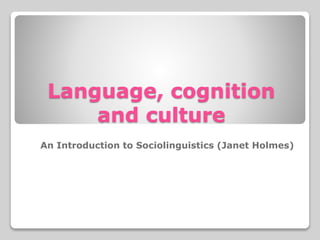
Linguistic categories and culture. Fatimah Abu-Srair
- 1. Language, cognition and culture An Introduction to Sociolinguistics (Janet Holmes)
- 2. Linguistic categories and culture Native American and Australian aboriginal language are often cited as examples which roundly refute popular misconception about primitive language . For example : mistaken claims that ‘simple societies cant have complex grammars’ .
- 3. Kwakiutl a native American language , for example , requires a grammatical classification of noun based on whether they are visible or not . And while French requires every noun be assigned to one of two genders , Dyirbal , an Australian aboriginal language , has four such categories .
- 4. Using western criteria the traditional nomadic lifestyle of the aboriginal people of Australia seems very simple . Their culture , however , is thousands of years old and their language are amongst the most interesting and grammatically complex that have been researched .Every noun in Dyirbal belongs to one of the four classes . Consequently whenever a Dyirbal speaker uses a noun in a sentence the noun must be preceded by one of the f our classifiers ; bayi ,balan ,balam or bala .
- 5. Language provides a means of encoding a community's knowledge ,beliefs and values i.e. its culture .Tahitians don’t make a distinction between ‘sadness’ and ‘sickness', for instance using the same word for both .this accurately represents their belief that ‘sadness/sickness can be attributed to an attack by evil spirits , a belief that may initially seem odd to someone from western culture .
- 6. The Cost of Language Lost e.i.: Ubykh Without George Dumezil’s commitment to language description, we would never have known about the linguistic complexities of Ubykh.
- 7. Until 1959, When people discovered the Amazonian tribe who speak Hixkaryana, a crib language, linguists had speculated that no human language used a word order wich involved the object (O) at the beginning of a sentence and the subject at the end (S) with the verb (V) in between: I.e. OVS. Hixkaryana scuttled that theory and forced desciptive and theoretical linguists to think again about linguistic possibilities.
- 8. And perhaps even more importantly, this discovery forced cognitive linguists to reconsider the range of formal constraints on human cognition, and the kind of rules the human brain can cope with. Information on possible cognitive limitation on human thinking is relevant in a number of areas, including research on the brain,
- 9. Where it suggests ways of treating brain damage, and information technology, where the limits of what human beings can conceptualise clearly affects what it possible in computer programming. In terms of the environment too, language lost can be costly.
- 10. e.i. 10 When we lose a language which makes subtle distinctions between plants on the basis of medical properties, or which encodes important biological and environmental knowledge which may not be obvious to outsiders, we lose information which may be difficult to retrieve.
- 11. Language also entails the loss of insights about human perception. e.i. 11
- 12. Finally, When people loss their language, their distinctive socio- cultural identity is also put at risk. Language and culture are clearly closely related. People whose language has been swamped by another often lose confidence in their abilities and develop poor self- esteem. While many other factors are also relevant, language loss in such cases is at least a contributing factor in educational and socio-economic under-performance.
- 13. Language ,social and cognition In Example 13 they include that : Middle-class children do well in school . Working-class children don’t do well in school Middle-class children speak a different variety of English than the working-class children .
- 14. In previous section provided an example of the potentially punitive social implications of culturally different ways of interacting , even when both group are using varieties of the same language .other have been interested in whether are possible cognitive implications where groups use different varieties of a language. Basil Bernstein was a sociologist who asked this question in the 1960s .
- 15. Like many educationalists , he was concerned that British children from working-class backgrounds were not progressing well at school .it was also widely recognissed that working-class spoke English differently from middle-class children . Researchers began to examine features of working – class children’s speech , looking for an explanation there .
- 16. Unfortunately , they assumed that the kind of language working-class children used in a formal interview situation to a middle-class adult was an accurate representation of their sociolinguistic competence . In such situations , not surprisingly , the children used short , even monosyllabic , responses which suggested to the interviewers that their linguistic resources were “restricted”
- 17. conclusion
